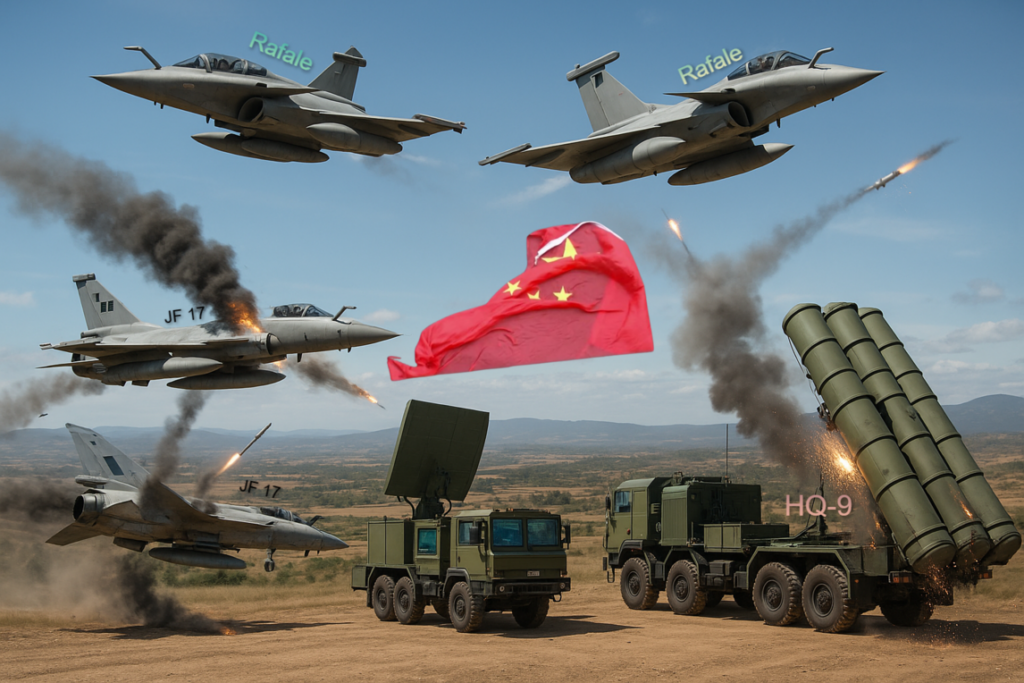
- Chinese military technology, marketed with grandiose claims of parity with the West, was exposed as second-rate and ineffective against a determined and well-coordinated Indian operation.
- Far from coming to Islamabad’s rescue, Beijing was forced into a position of strategic withdrawal, revealing the limits of its support and the primacy of its global economic and diplomatic interests over ideological or military alignments.
- Despite being equipped with Chinese-origin JF-17 Thunder jets, Al-Khalid tanks, and the HQ-9 surface-to-air missile systems, the Pakistan military failed to either prevent the incursion or retaliate effectively.
- Even before Operation Sindoor commenced, Indian diplomats were active in Washington, Paris, Moscow, and key Middle Eastern capitals, sharing intelligence and laying the groundwork for international support.
The events following the deadly terrorist attack in Pahalgam in March 2025, which claimed the lives of scores of Indian civilians and security personnel, initiated a decisive and assertive military response from India in the form of Operation Sindoor. This operation, conducted with precision and moral legitimacy, was aimed at dismantling terrorist infrastructure operating with impunity across the Line of Control in Pakistan-occupied Kashmir. In this high-stakes geopolitical episode unfolding, one nation found itself cornered in a diplomatically awkward and strategically revealing situation- China. Historically seen as Pakistan’s “all-weather friend,” China’s silence, reluctance, and ultimate inaction during Pakistan’s hour of need exposed the transactional core of Sino-Pakistani relations. Far from coming to Islamabad’s rescue, Beijing was forced into a position of strategic withdrawal, revealing the limits of its support and the primacy of its global economic and diplomatic interests over ideological or military alignments. This article examines the contours of China’s discomfort, its inability to impress or support Pakistan militarily or diplomatically, and how India’s superior statecraft won global backing while leaving China isolated.
The Pahalgam Attack and Operation Sindoor: A Watershed
The Pahalgam terrorist attack shocked the Indian nation and drew widespread international condemnation. The attack bore the familiar signature of cross-border terrorism, with credible evidence pointing toward Pakistan-based groups. The Indian government, under Prime Minister Narendra Modi’s leadership, responded not just with rhetoric but with resolute action. Operation Sindoor was conceived as a swift and limited military campaign targeting launch pads, safe houses, and supply chains used by terrorist outfits in Pakistan-occupied territories. India’s precision strikes were calibrated to avoid civilian casualties and prevent escalation into a full-scale war. Nevertheless, they served as a strong message that India’s strategic patience had run out. The operation also transformed India’s counterterrorism doctrine -from reactive diplomacy to proactive disruption.
China’s Illusion of Deterrence Fails
For decades, China has supplied Pakistan with weapons systems ranging from fighter jets and drones to nuclear technology and short-range ballistic missiles. The goal has been dual: to strengthen Pakistan against India and keep the subcontinent in a state of strategic flux. However, when Operation Sindoor was launched, this entire edifice of deterrence came crashing down. Despite being equipped with Chinese-origin JF-17 Thunder jets, Al-Khalid tanks, and the HQ-9 surface-to-air missile systems, the Pakistan military failed to either prevent the incursion or retaliate effectively. India’s superior air defence systems, integrated battlefield awareness, and cyber dominance overwhelmed Pakistan’s largely outdated and imported arsenal. Chinese military technology, marketed with grandiose claims of parity with the West, was exposed as second-rate and ineffective against a determined and well-coordinated Indian operation. This failure severely dented China’s prestige as a defence supplier. It raised uncomfortable questions within Pakistan’s security establishment about its over-reliance on Chinese military hardware and Beijing’s actual commitment in the event of a full-blown crisis.
Operation Sindoor, conducted with precision and moral legitimacy, was aimed at dismantling terrorist infrastructure operating with impunity across the Line of Control in Pakistan-occupied Kashmir.
Beijing’s Strategic Silence: The Myth of All-Weather Friendship
Perhaps the most telling moment was China’s near-total diplomatic silence during and after Operation Sindoor. While Pakistan made frantic appeals to Beijing for intervention — if not militarily, at least diplomatically — China offered little more than perfunctory statements urging “restraint on both sides.” There was no call for a United Nations Security Council meeting, no active shuttle diplomacy, and certainly no military posturing. For Pakistan, which has long romanticised the idea of China as a geostrategic counterweight to India and a security guarantor, this was a rude awakening. Beijing’s decision not to escalate or intervene was based on cold calculations. With over $120 billion in annual trade with India, Chinese leaders were acutely aware that taking sides could jeopardise critical economic interests. In contrast, Pakistan’s spiralling economy, political instability, and over-dependence on bailouts made it a strategic liability, not an asset. China’s Belt and Road Initiative (BRI), especially the China-Pakistan Economic Corridor (CPEC), was another complicating factor. Any instability in Pakistan threatened China’s energy and trade lifelines. Therefore, Beijing’s preferred course was to de-escalate and avoid confrontation, even if that meant abandoning its “iron brother” in a time of need.
India’s Diplomatic Masterstroke: Isolating Pakistan, Cornering China
India’s diplomatic response to the Pahalgam attack and subsequent military actions was a textbook example of strategic communication and alliance-building. Even before Operation Sindoor commenced, Indian diplomats were active in Washington, Paris, Moscow, and key Middle Eastern capitals, sharing intelligence and laying the groundwork for international support. The results were swift and stunning. From the United States to France, and from Japan to Australia, world powers either explicitly supported India’s right to self-defence or refrained from criticising the operation. Even traditionally cautious countries like Russia maintained neutrality, reflecting growing trust in India’s responsible use of force. The Quad nations closed ranks diplomatically, and India’s rising stature in the Global South ensured that even African and Latin American states did not fall for Pakistan’s narrative of victimhood.
Only Turkey and Azerbaijan — both aligned with Islamabad and driven by Islamic solidarity- issued pro-Pakistan statements. Their rhetoric, however, was largely ignored in the broader international discourse. China, interestingly, found itself unable to gather any significant coalition to counter India’s narrative. Its recent disputes with Europe, tensions with the US, and assertive posturing in the Indo-Pacific made it an unlikely rallying figure.
The Exposed Facade of Sino-Pak Ties
The events after Pahalgam laid bare the true nature of the China-Pakistan relationship. Far from being a deep-rooted alliance based on shared values or strategic convergence, it emerged as a relationship of convenience. For China, Pakistan is a buffer, a market, a conduit, and occasionally, a provocateur. But it is not — and has never been — a partner for whom China is willing to risk its global standing or economic future. This realisation is likely to have a lasting impact on Pakistan’s foreign and defence policies. The myth of an “iron brotherhood” was shattered in real-time as China watched silently while India executed precision strikes on Pakistani territory. If this is what “all-weather friendship” looks like in crisis, then the strategic value of that friendship is questionable at best and delusional at worst.
India’s precision strikes were calibrated to avoid civilian casualties and prevent escalation into a full-scale war.
China’s Business-First Foreign Policy
The fundamental reason behind China’s awkward moment lies in its foreign policy, which is increasingly driven by economic imperatives. As the world’s second-largest economy and a major exporter, China cannot afford military entanglements that threaten trade relations or bring sanctions. Beijing’s actions in 2025 were dictated not by loyalty or ideological alignment but by sheer pragmatism. Supporting Pakistan at the cost of alienating India, jeopardising trade routes, or inviting international scrutiny was simply not worth it. As India’s economy continues to grow, and as global companies diversify supply chains away from China, Beijing finds itself needing stable relations with New Delhi, not confrontations. This is a critical lesson for Pakistan’s policymakers: in times of existential crises, China’s support will always be secondary to its economic calculus. Beijing may sell weapons and fund infrastructure, but it will not shed blood or sacrifice global standing for Pakistan’s cause.
Lessons for Pakistan: Time for Strategic Recalibration
The 2025 confrontation should serve as a moment of reckoning for Pakistan. Its reliance on non-state actors as instruments of state policy, its dependence on China for diplomatic cover and military support, and its unwillingness to engage in regional peace initiatives have all been exposed as costly miscalculations. If anything, the episode shows that Pakistan must diversify its foreign policy, focus on internal stability, and adopt a more responsible approach to its neighbourhood. The illusion that China will step in to counterbalance India has been decisively disproved.
The world, by and large, stood by India, while Pakistan’s cries found few echoes and China’s silence was deafening.
Conclusion: The Strategic Emergence of India
The aftermath of the Pahalgam attack and Operation Sindoor marks a new phase in South Asian geopolitics. It reflects the rising confidence, capability, and credibility of India, both as a regional power and a responsible global stakeholder. India not only succeeded militarily but also emerged victorious in the battle of narratives. The world, by and large, stood by India, while Pakistan’s cries found few echoes and China’s silence was deafening. China’s failure to back its so-called ally during a moment of crisis illustrates a deep contradiction in its foreign policy. It aspires to be a global leader but acts like a mercantilist power focused on trade, control, and caution. For countries like Pakistan, this means learning that relationships built on transactional logic are never substitutes for genuine alliances. India, on the other hand, showcased a model of strategic autonomy, balancing firmness with restraint, and action with diplomacy. The episode has sent an unmistakable message: India can and will defend its interests, and the world will respect it for doing so. In a multipolar world where credibility is capital, China’s awkward moment has only reinforced India’s ascent and Pakistan’s isolation.
Dr. Nanda Kishor M. S. is an Associate Professor at the Department of Politics and International Studies, Pondicherry University, and former Head of Geopolitics and International Relations at Manipal University. His expertise spans India’s foreign policy, conflict resolution, international law, and national security, with several publications and fellowships from institutions including UNHCR, Brookings, and DAAD. The views expressed are the author’s own.
